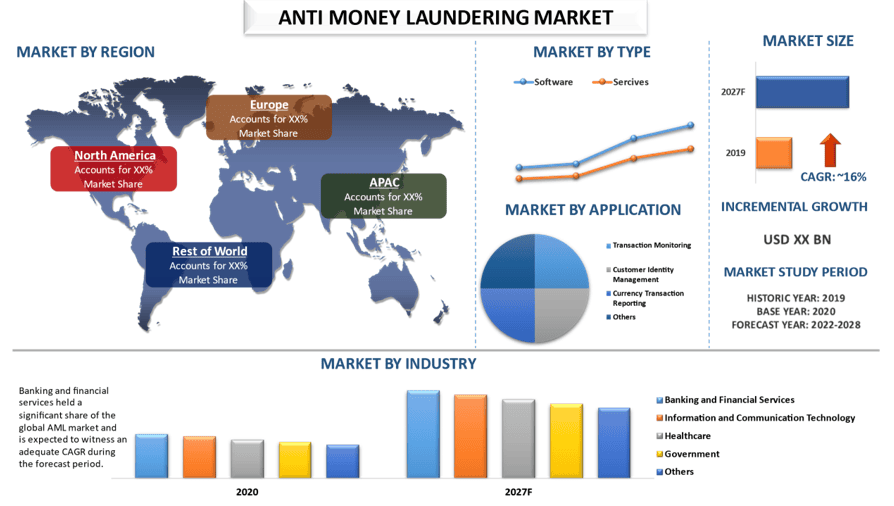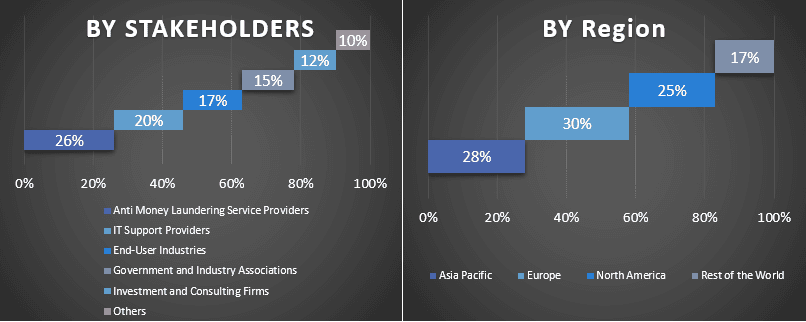Рынок борьбы с отмыванием денег: текущий анализ и прогноз (2022-2028 гг.)
Акцент на типе (программное обеспечение и услуги); развертывании (облако и локальная инфраструктура); применении (мониторинг транзакций, управление идентификацией клиентов, отчетность по валютным операциям и прочее); отрасли (банковские и финансовые услуги, информационно-коммуникационные технологии, здравоохранение, государственное управление и прочее); и регионе/стране

ЗАПРОСИТЬ БЕСПЛАТНЫЙ ОБРАЗЕЦ PDF
Ожидается, что глобальный рынок борьбы с отмыванием денег будет регистрировать среднегодовой темп роста около 16% в период с 2021 по 2027 год. Глобальный рынок AML растет из-за увеличения случаев отмывания денег, а также растущего использования электронных и цифровых методов оплаты. Кроме того, поддерживающие государственные инициативы, направленные на безналичные транзакции и пресечение неэтичной деятельности, такой как отмывание денег, способствуют росту рынка. Кроме того, правительства разных стран содействуют развитию безналичной экономики и создают надежную инфраструктуру цифровых платежей для сокращения или полного прекращения отмывания денег. Далее, по данным Международного валютного фонда (МВФ), оценочная сумма денег, отмываемых во всем мире за один год, составляет от 2% до 5% мирового ВВП, или от 800 млрд долларов США до 2 трлн долларов США. 5% - это самая консервативная цифра, фактическое число, скорее всего, выше. Отмывание денег часто поддерживает такие преступления, как контрабанда, незаконная продажа оружия, инсайдерская торговля, взяточничество и многие другие мошеннические схемы. Кроме того, расширение использования передовой аналитики в AML и интеграция искусственного интеллекта, машинного обучения и анализа больших данных в разработку решений AML откроют прибыльные возможности для поставщиков решений AML.
ЗАПРОСИТЬ ИНДИВИДУАЛЬНУЮ НАСТРОЙКУ
Аналитическая информация, представленная в отчете
«Среди приложений, категория мониторинга транзакций занимала значительную долю на рынке в 2020 году»
На основе применения рынок борьбы с отмыванием денег сегментируется на мониторинг транзакций, управление идентификацией клиентов, отчетность о валютных операциях и другие. Сегмент мониторинга транзакций захватил значительную долю рынка в 2020 году. Мониторинг отмывания денег и выявление мошенничества с платежами, а также мониторинг и управление новыми платежными каналами являются одними из основных факторов, способствующих росту этого сегмента. Мониторинг транзакций - это процесс мониторинга транзакций клиентов. Система мониторинга транзакций выявляет подозрительное поведение, которое может указывать на отмывание денег или другое финансовое преступление. Это одна из самых важных частей предотвращения отмывания денег и финансирования терроризма.
«Среди отраслей, категория банковских и финансовых услуг занимала значительную долю на рынке в 2020 году»
На основе отраслей рынок AML сегментируется на банковские и финансовые услуги, информационно-коммуникационные технологии, здравоохранение, правительство и другие. Сегмент банковских и финансовых услуг захватил значительную долю рынка. Одной из основных причин роста банковских и финансовых услуг является поддерживающая политика, введенная правительствами. Банки сталкиваются с последовательным увеличением риска мошенничества и финансовых преступлений, возникающих в результате цифровизации и автоматизации финансовых систем и увеличения количества онлайн-транзакций. Нормативные акты AML определяют протоколы, которым банки должны следовать для предотвращения и выявления финансовых преступлений, что создает спрос на решения AML в сегменте банковских и финансовых услуг.
«Ожидается, что Северная Америка станет свидетелем значительного роста в течение прогнозируемого периода»
Ожидается, что рынок борьбы с отмыванием денег в Северной Америке станет свидетелем значительного среднегодового темпа роста в течение прогнозируемого периода. Рост этого рынка можно объяснить присутствием основных поставщиков решений AML и введением жестких государственных постановлений о развертывании решений AML в финансовых институтах региона. Нормативные акты AML определяют меры, которые банки должны принимать во внимание для предотвращения и выявления финансовых преступлений, что создает спрос на решения по борьбе с отмыванием денег в сегменте банковских и финансовых услуг. Ожидается, что наличие большого количества банков также будет стимулировать внедрение решений по борьбе с отмыванием денег в регионе в ближайшем будущем.
Кроме того, правительственные нормативные акты AML и поддерживающая государственная политика в отношении отмывания денег стимулируют рост рынка в регионе. Кроме того, увеличение частоты кибератак и мошенничества, а также быстрый рост внедрения искусственного интеллекта и анализа больших данных в банковском секторе помогут региону сохранить свои позиции в течение прогнозируемого периода.
Причины купить этот отчет:
- Исследование включает анализ размеров рынка и прогнозирование, подтвержденный проверенными ключевыми экспертами отрасли.
- Отчет представляет собой краткий обзор общей производительности отрасли с первого взгляда.
- Отчет охватывает углубленный анализ видных игроков отрасли с основным упором на ключевые финансовые показатели бизнеса, портфель продуктов, стратегии расширения и последние разработки.
- Подробное изучение факторов, ограничений, ключевых тенденций и возможностей, преобладающих в отрасли.
- Исследование всесторонне охватывает рынок по различным сегментам.
- Углубленный анализ отрасли на региональном уровне.
Варианты настройки:
Глобальный рынок борьбы с отмыванием денег может быть дополнительно настроен в соответствии с требованиями или любым другим сегментом рынка. Кроме того, UMI понимает, что у вас могут быть свои собственные бизнес-потребности, поэтому не стесняйтесь обращаться к нам, чтобы получить отчет, который полностью соответствует вашим требованиям.
Содержание
Методология исследования анализа рынка борьбы с отмыванием денег (AML) (2021-2027 гг.)
Анализ исторического рынка, оценка текущего рынка и прогнозирование будущего рынка глобального рынка AML были тремя основными этапами, предпринятыми для создания и анализа внедрения AML в основных регионах мира. Было проведено исчерпывающее вторичное исследование для сбора данных об историческом рынке и оценки текущего размера рынка. Во-вторых, для проверки этих выводов было принято во внимание множество результатов и предположений. Кроме того, были проведены исчерпывающие первичные интервью с отраслевыми экспертами по всей цепочке создания стоимости глобального рынка AML. После предположений и проверки рыночных показателей посредством первичных интервью мы применили восходящий/нисходящий подход к прогнозированию полного размера рынка. После этого были приняты методы декомпозиции рынка и триангуляции данных для оценки и анализа размера рынка сегментов и подсегментов, к которым относится отрасль. Подробная методология описана ниже:
Узнать больше о методологии исследования
Анализ исторического размера рынка
Шаг 1: Углубленное изучение вторичных источников:
Было проведено подробное вторичное исследование для получения данных об историческом размере рынка AML из внутренних источников компании, таких как годовые отчеты и финансовые отчеты, презентации результатов деятельности, пресс-релизы и т. д., и внешних источников, включая журналы, новости и статьи, правительственные публикации, публикации конкурентов, отраслевые отчеты, сторонние базы данных и другие достоверные публикации.
Шаг 2: Сегментация рынка:
После получения данных об историческом размере рынка AML мы провели подробный вторичный анализ для сбора данных об историческом рынке и доли для различных сегментов и подсегментов в основных регионах. Основные сегменты, включенные в отчет: тип, развертывание, применение и отрасль. Был проведен дальнейший анализ на уровне стран для оценки общего внедрения моделей тестирования в этом регионе.
Шаг 3: Факторный анализ:
После получения данных об историческом размере рынка различных сегментов и подсегментов мы провели подробный факторный анализ для оценки текущего размера рынка AML. Кроме того, мы провели факторный анализ с использованием зависимых и независимых переменных, таких как различные типы, развертывание, применение и отрасль AML. Был проведен тщательный анализ сценариев спроса и предложения с учетом ведущих партнерств, слияний и поглощений, расширения бизнеса и запуска продуктов в секторе рынка AML по всему миру.
ЗАПРОСИТЬ ИНДИВИДУАЛЬНУЮ НАСТРОЙКУ
Оценка текущего размера рынка и прогноз
Определение текущего размера рынка: На основе действенных выводов, полученных на основе вышеуказанных 3 шагов, мы пришли к текущему размеру рынка, ключевым игрокам на глобальном рынке AML и долям рынка сегментов. Все необходимые процентные доли и разбивки рынка были определены с использованием вышеупомянутого вторичного подхода и были проверены посредством первичных интервью.
Оценка и прогнозирование: Для оценки рынка и прогнозирования различным факторам были присвоены веса, включая движущие силы и тенденции, ограничения и возможности, доступные для заинтересованных сторон. После анализа этих факторов были применены соответствующие методы прогнозирования, то есть восходящий/нисходящий подход, чтобы прийти к прогнозу рынка примерно на 2027 год для различных сегментов и подсегментов на основных рынках мира. Методология исследования, принятая для оценки размера рынка, включает:
- Размер рынка отрасли с точки зрения выручки (доллары США) и уровень внедрения рынка AML на основных рынках страны
- Все процентные доли, разбивки и декомпозиции рыночных сегментов и подсегментов
- Ключевые игроки на рынке очистки AML с точки зрения предлагаемых решений. Кроме того, стратегии роста, принятые этими игроками для конкуренции на быстрорастущем рынке
Подтверждение размера и доли рынка
Первичное исследование: Были проведены углубленные интервью с ключевыми лидерами мнений (KOL), включая руководителей высшего звена (CXO/VPs, руководители отдела продаж, руководители отдела маркетинга, руководители операционного отдела и региональные руководители, руководители стран и т. д.) в основных регионах. Затем были обобщены результаты первичного исследования и проведен статистический анализ для доказательства заявленной гипотезы. Входные данные первичного исследования были объединены с результатами вторичного исследования, превращая, таким образом, информацию в действенные выводы.
Разделение основных участников по различным регионам

Инжиниринг рынка
Метод триангуляции данных был использован для завершения общей оценки рынка и получения точных статистических данных по каждому сегменту и подсегменту глобального рынка AML. Данные были разделены на несколько сегментов и подсегментов после изучения различных параметров и тенденций в областях типа, развертывания, применения и отрасли на глобальном рынке AML.
Основная цель исследования глобального рынка AML
В исследовании были точно определены текущие и будущие рыночные тенденции глобального рынка AML. Инвесторы могут получить стратегические выводы, чтобы основывать свои решения для инвестиций на качественном и количественном анализе, проведенном в исследовании. Текущие и будущие рыночные тенденции определили общую привлекательность рынка на региональном уровне, предоставив промышленным участникам платформу для эксплуатации неиспользованного рынка, чтобы извлечь выгоду в качестве первопроходца. Другие количественные цели исследований включают:
- Анализ текущего и прогнозируемого размера рынка AML в стоимостном выражении (доллары США). Также анализ текущего и прогнозируемого размера рынка различных сегментов и подсегментов
- Сегменты в исследовании включают области типа, развертывания, применения и отрасли.
- Определение и анализ нормативно-правовой базы для индустрии рынка AML.
- Анализ цепочки создания стоимости, связанной с присутствием различных посредников, а также анализ поведения клиентов и конкурентов в отрасли.
- Анализ текущего и прогнозируемого размера рынка AML для основного региона.
- Основные страны регионов, изученные в отчете, включают Азиатско-Тихоокеанский регион, Европу, Северную Америку и остальной мир.
- Профили компаний рынка AML и стратегии роста, принятые участниками рынка для поддержания деятельности на быстрорастущем рынке
- Углубленный анализ отрасли на региональном уровне
Связанные Отчеты
Клиенты, купившие этот товар, также купили










